UNDER CONSTRUCTION: Check Back Frequently
American Admiralty Books Safety & Privacy Policies, Links here take you outside of our site, some cites may use "cookies".
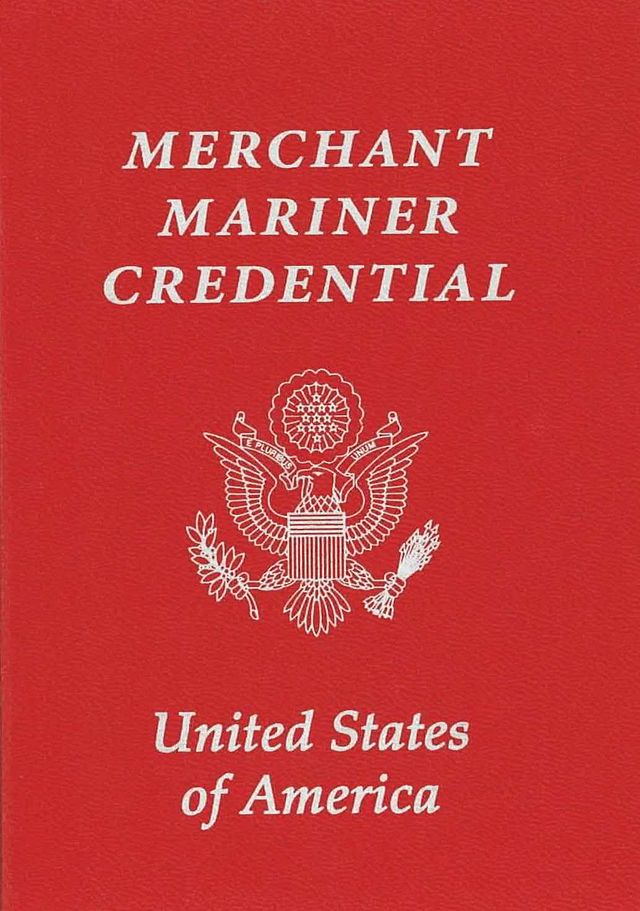 PD New Merchant Mariner Pass Port Style Credential
PD New Merchant Mariner Pass Port Style Credential
 |
| PD OLD STYLE OFFICERS LICENSE |
THE PURPOSE OF THIS SECTION IS TO HELP THOSE U.S. MARINERS PREPARING TO UNDERGO A "LICENSE PREP" COURSE TO PREPARE IN ADVANCE SO AS TO MAXIMIZE THEIR CHANCES OF PASSING THEIR COAST GUARD ADMINISTERED OCCUPATIONAL CREDENTIALING EXAM ON THE FIRST ATTEMPT.
"Professional vocational educators know that humans tend to retain only about 10% of what they read over protracted time, 50% of what we see and hear, but 90% of what we say and do ourselves. What we try to do in this section is to provide in one convenient location links to such free video sources of instruction in the various examination subjects as we are able to locate so that the student preparing for attendance at a "license prep" course will be able to add at no additional expense some of that "see and hear" type material that tends to increase retention to about 50%. More over we suggest to those who make use of this free resource that you view each video several times and take notes after the first run through. By putting things in your own words and writing them out you introduce the "Say and do " function in learning and raise that 50% comprehension/retention rate to closer to 90%."
 |
| Old Diploma Style Officer's License |
After initial training American merchant mariners in the various entry and intermediate officer grades and seamen' ratings are expected to serve out minimal tours of duty in the subordinate grades before becoming eligible for Coast Guard administered vocational credentialing examinations. American shipping companies are very limited in their ability to promote from within. Shipping companies or ship masters may for example select from among their available USCG certified Able Seamen which may serve in specialized or supervisory capacities such as Quartermaster, or Boatswain. But these same companies may not promote an Ordinary Seaman to Able Seaman without the individual passing the official Able Seaman examination administered by the U.S. Coast Guard.
Many American Merchant Mariners of both officer grades and ratings take "license preparatory", or "exam prep" courses from a variety of providers both public and private before attempting the occupational advancement examinations. These typically last three days to two weeks and are very focused on the examination and typical questions. The better schools also provide some refresher and introductory training in subjects that weren't covered on the applicant's last exam and are new to the hoped for advanced grade. Nearly every school advises prospective students to study all exam subjects before arriving at school.
Unfortunately it is often very difficult and expensive to gather all good study materials. More over these tend to be printed materials, available videos tend to be very expensive. Professional vocational educators know that humans tend to retain only about 10% of what they read over protracted time, 50% of what we see and hear, but 90% of what we say and do ourselves. What we try to do in this section is to provide in one convenient location links to such free video sources of instruction in the various examination subjects as we are able to locate so that the student preparing for attendance at a "license prep" course will be able to add at no additional expense some of that "see and hear" type material that tends to increase retention to about 50%. More over we suggest to those who make use of this free resource that you view each video you select several times and take notes after the first run through. But putting things in your own words and writing them out you introduce the "Say and do " function in learning and rise that 50% comprehension/retention rate to closer to 90%.
We have been able so far to to locate far more materials on deck subjects than engineering, but it is our intention to build a strong engineering collection in the future. Like all parts of the American Admiralty Books Blog this section is very much a work in progress and we invite you to check in often to view new materials, updated materials and new additions.
We wish to thank all of those who prepared the materials linked to in this section who published them on YouTube and similar venues thus making them available for public use without charge. We are very mindful that we are only collators and linkers of the material. The greater volume of work was done by the original video makers who have been quite generous in posting their work for use by the public.
---------------------------------------------------------------------------------------------------------------------
SOME GENERAL INFORMATION ABOUT USCG PROFESSIONAL MARINER OCCUPATIONAL CREDENTIALING:
HOW TO GET YOUR "CAPTAIN'S LICENSE" "Captain's license" refers in this case to the rather limited "Motor Boat Operator" license through the 100 ton "Master's License". These licenses are typical of those seen in the charter boat industry and smaller excursion and ferry industries. The number of subjects examined for are limited in comparison to "credentials required on larger commercial vessels". However the process described in very similar to all merchant mariner credentialing processes, so if you are a complete novice to the system, or interested specifically in one of these limited licenses you may find this video very useful;. Pay particular attention to the concept of the "USCG Packet" described in this video: https://www.youtube.com/watch?v=BjT5ktQ3fbM
------------------------------------------------------------------------------
"SEA SERVICE REQUIREMENTS": A video on how to document "sea Service for meeting minimum service requirements for initial certification of advancement: https://www.youtube.com/watch?v=QbtuoNuSjhk
-----------------------------------------------------------------------------
DRUG TESTING REQUIREMENTS FOR MERCHANT MARINER'S LICENSES:
This video directly addresses mostly motor boat operator through 100 ton masters requirements but all merchant mariner documents require drug testing and the requirements are very similar.https://www.youtube.com/watch?v=xvJhBKOLPDM&index=4&list=PL68B98D0FA7BE32EA
---------------------------------------------------------------------------
TWIC CARDS: Most commercial mariners will require possession of a TWIC card (Transportation Worker Identification Card) before being accepted for Coast Guard examination:https://www.youtube.com/watch?v=2D1Ej4o76uk&list=PL68B98D0FA7BE32EA&index=5
---------------------------------------------------------------------------
THE FIRST AND ONE OF THE TWO MOST TIGHTLY GRADED SECTIONS OF THE DECK OFFICER AND RATINGS EXAMINATIONS:
"NAV RULES" AKA "NAVIGATION RULES", "RULES OF THE ROAD", RULES TO AVOID COLLISION:
"The Rules to Avoid Collision" are divided into two sets. The first is the U.S. Inland Navigation Rules which apply generally inland of the sea buoys. One of the first rules you must learn is the "line of demarcation" between the U.S. Inland Rules and the International Rules of the Road, which in fact are very similar and even identical in a number of areas. Generally whether going up for Able Seaman, or Master Mariner you can not "Over study" these rules since the MINIMUM PASSING SCORE ON MOST OF THE EXAMS IS 90% .
 PD
PD
A Good Start:
Collision Avoidance Nav Rules ( A basic introduction for recreational boaters or first time motorboat license applicants, or useful to anyone who has not reviewed the rules in a long time: Highly visual, well narrated, simplified about 1 hr. 42 minutes running time.) https://www.youtube.com/watch?v=19suVDp8GnM
A detailed look at one of the most detailed sources of test questions:
COLREGS: The lights and day shapes of the International Rules animated and narrated: 25 minutes play time: https://www.youtube.com/watch?v=8sb96kbeoZM
ACTUAL TEXT OF THE INLAND AND INTERNATIONAL RULES AS PUBLISHED BY THE U.S. COAST GUARD (Text only) 218 pages with some illustrations particularly lights and day marks.) http://www.navcen.uscg.gov/pdf/navRules/COMDTINST_M16672_2D_NavRules_as_published.pdf http://www.navcen.uscg.gov/pdf/navRules/COMDTINST_M16672_2D_NavRules_as_published.pdf
A reference not a video:
USCG CENTER OF EXCELLENCE NAV RULES SPECIAL AND INTERPRETATIVE RULES ( TEXT ONLY) http://www.navcen.uscg.gov/?pageName=navRulesContent
Sample USCG test questions: http://jule-iii.com/cgi-bin/uscg/uscg.pl?Book=1&mode=All&
-----------------------------------------------------------------------------
THE SECOND OF THE TWO MOST TIGHTLY GRADED SECTIONS OF THE PROFESSIONAL DECK OFFICER'S EXAMINATIONS:
NAVIGATION: Another minimum score 90% subject for deck officers. The level of navigation required varies with any restrictions as to route on the mariner's document sought such as "Inland". "Lakes, Bays, and Sounds", "Coastwise", "Any Ocean".

Smart Boating Series Basic Navigation N8982DVD Extremely basic introduction 10 minutes run time. https://www.youtube.com/watch?v=lGTnfrEjgPM
AIDS TO NAVIGATION: 5 minute basic introduction: https://www.youtube.com/watch?v=G1m09KD3GFw
FOR MANY INLAND VOYAGES ON FEDERAL NAVIGABLE WATERS THE ROUTE IS LITERALLY MARKED BY VISUAL "AIDS TO NAVIGATION" VIRTUAL NAUTICAL ROAD SIGNS. Here is a video with a run time of about 1.5 hours explaining the system.
https://www.youtube.com/watch?v=RIen2AOKsa0
AIDS TO NAVIGATION 7 videos to chose from: https://www.youtube.com/watch?v=iecnBRAO8wo&list=PLEB44611CBEBCFFD3
JUST FOR FUN: THE HISTORY OF NAVIGATION A 1 Hour PBS Special: https://www.youtube.com/watch?v=8zyA4qQ7EvI
----------------------------------------------------------
CHART NAVIGATION
NAVIGATION PART 1: an introduction in a 333 minute video: https://www.youtube.com/watch?v=vHBQn66mEek
NAVIGATION PART II: Picks up where part I ends and continues to the end of basic coastal chart navigation. 53 minute video: https://www.youtube.com/watch?v=6sIyVJzmf2k
Below are a number of videos that go into more detail on some of the subjects covered in the above two videos: Below that you'll find some videos on celestial navigation for those interested or required to pass a celestial navigation as is typical for most "ocean" licenses.
TOOLS: https://www.youtube.com/watch?v=A5WmKHvLwFE 9 minute video
CHART NAVIGATION
NAVIGATION PART 1: an introduction in a 333 minute video: https://www.youtube.com/watch?v=vHBQn66mEek
NAVIGATION PART II: Picks up where part I ends and continues to the end of basic coastal chart navigation. 53 minute video: https://www.youtube.com/watch?v=6sIyVJzmf2k
Below are a number of videos that go into more detail on some of the subjects covered in the above two videos: Below that you'll find some videos on celestial navigation for those interested or required to pass a celestial navigation as is typical for most "ocean" licenses.
TOOLS: https://www.youtube.com/watch?v=A5WmKHvLwFE 9 minute video
Chart Plotting and Navigation 101 https://www.youtube.com/watch?v=mQavTIks2r8 12 minute video
Dead Reckoning - the basics`: The simplest and most basic form of navigation 4 minute introduction: https://www.youtube.com/watch?v=Ahroe-DidO8
Estimated Position: The type of position that Dead Reckoning brings you to, different from a "fix" 3 minute introduction: https://www.youtube.com/watch?v=KchHul7gs6g
Dead Reckoning Plotting, Use of a Universal Plotting Sheets:
31 minute video: https://www.youtube.com/watch?v=eE0KzIf7e5I
How to plot a three point fix on a chart: 2 minute video
https://www.youtube.com/watch?v=hcSnN8pTdYQ
Course to Steer - one hour of tide: 6 minute video https://www.youtube.com/watch?v=rYKAOBfWiKk
COMPASS CORRECTION: Nearly all routes prescribed on mariner's documents will require knowledge of magnetic compasses. The most important thing to keep in mind about the magnetic compass is that it does not point constantly to "True North" but to an area in the very rough vicinity of the true geographic North Pole known as the "North Magnetic pole". In order to be able to navigate accurately with a magnetic compass the navigator, skipper, coxswain, or watch officer must be able to "correct" "Compass error". Below is a video that explains this process:
COMPASS CORRECTION: https://www.youtube.com/watch?v=i945NfNVuHk Run time approximately 15 minutes.
CELESTIAL NAVIGATION: Applicants for unlimited tonnage and route (oceans) deck officers licenses must generally demonstrate a knowledge of celestial navigation ( navigation by the sun, and stars) using instruments in addition to the those common to basic chart navigation. These additional instruments are foremostly represented by the sextant:
Celestial Navigation: Sextant Basics https://www.youtube.com/watch?v=B_uEWNPnpiY 30 miute video
How to use a sextant: Wikipedia animation https://www.youtube.com/watch?v=MEN6I9_VlFk 30 sec video
Getting Started in Celestial Navigation (The Marine Sextant) 7 minute video
immediately following the animation described above. https://www.youtube.com/watch?v=DrAkrgZRb9Y
Getting Started in Celestial Navigation (The Noon Sight for Latitude) https://www.youtube.com/watch?v=BWGOlpj4YwE https://www.youtube.com/watch?v=BWGOlpj4YwE 11 minute video
Celestial Navigation Math: 10 minute basic introduction video: https://www.youtube.com/watch?v=XWLZKmPU17M
Find North with the Stars - Polaris & Ursa Major - Celestial Navigation https://www.youtube.com/watch?v=n_gT9nBfhfo 11 minute video
--------------------------------------------------------------------------
SEAMANSHIP SECTION:
Seamanship is a general section found on all deck credential examinations from Able Seaman to Master Mariner. Seamanship is divided into a variety of subtopics such as marlinspike seamanship ( lines, ropes, knotting, splicing, coiling, etc.). Rigging ( blocks , tackles, computing breaking strength, safe working load, and mechanical advantage). Canvas and Sewing, Helmsmanship, Heavy Weather Operations, Towing, etc.. Exactly what is covered varies from credential exam by rating or officer grade. For example licences specifically targeted to the towing trades will have more towing questions. License exams focused on smaller vessels tend to have few large deck machinery questions. Able Seaman Exams tend to pose questions from the operators of deck machinery level while officer exams may include both features of typical operations and questions on maintenance and safety. Seamanship is generally a 70% minimum score test segment. Following this introduction are a series of links to videos on a broad spectrum of seamanship subjects including small, large, towing, and sailing vessels.
----------------------------------------------------------------------------
WHAT IS MARLINSPIKE SEAMANSHIP?
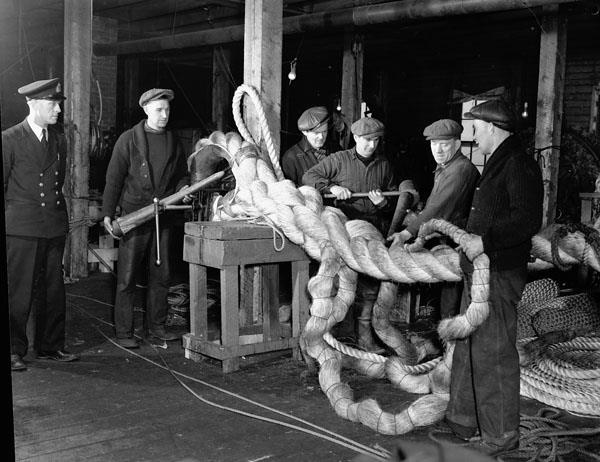 Workers splicing 20″ hemp cable at HMC Dockyard in 1941 image courtesy Library and Archives Canada
Workers splicing 20″ hemp cable at HMC Dockyard in 1941 image courtesy Library and Archives Canada
Editor's Note: This post has been updated since original publication and is being established for constant up dating and expansion in the MERCHANT MARINE SECTION. Last update as a post 12/21/2014. For the latest version of this post check the Merchant Marine Interest Section
Marlinespike seamanship includes but is not limited to knot tying and splicing, it covers the entire subject of the use of "line" (fiber rope) and wire rope in the realm of seamanship. This is not a subject that one can truly master by reading a book but to become a true master some study of certain books and rigging manuals is necessary. That level of skill is rarely needed by the recreational boater. At the professional level the subject includes some important mathematical computations like the computation of breaking strain and safe working load and safety factors. Certainly when hoisting anything of value or human beings using "running rigging" a mariner wants to know that the rigging will safely hold the load. Another computation that especially the professional must master is the computation of mechanical advantage in rigging blocks and tackles. This computation will tell you how much force will be needed to hoist or pull a load rigged for block and tackle.
We have scoured the internet and will continue to do so find the free instructional videos that will help anyone to learn basic marlinespike seamanship as it applies to the ordinary or able seaman or the recreational boater. We have also tried to assemble the videos available to help the basically competent gain skills in the more professional levels of splicing, rigging and decorative "fancy work". This video library is designed to be used as a course of self paced self instruction and as a ready reference work when attempting something unfamiliar. It is meant as a resource for professional mariners including Navy and Coast Guard rated boatswain's mates and recreational boaters alike. Use whatever you need or like. We have divided the videos into various topics and we indicate their approximate lengths. This is a perennial work in progress we post new works when we find them , expand on subjects as new free videos are posted and occasionally may have to pull and replace videos. Check back often and good luck with your mastery of marlinespike seamanship:
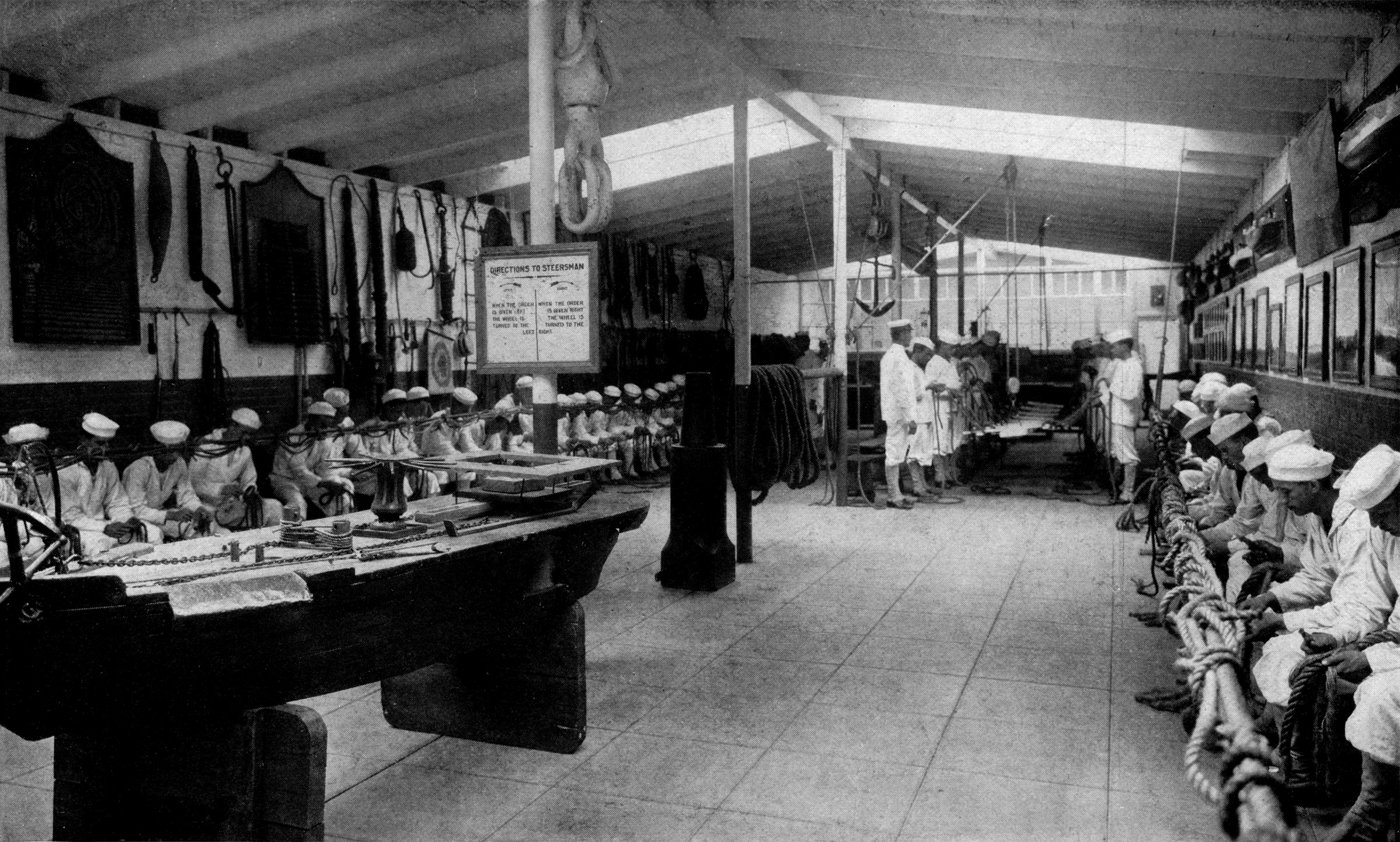 PD, sailors learning knotting & splicing in a rigging loft
PD, sailors learning knotting & splicing in a rigging loft
Seamanship is a general section found on all deck credential examinations from Able Seaman to Master Mariner. Seamanship is divided into a variety of subtopics such as marlinspike seamanship ( lines, ropes, knotting, splicing, coiling, etc.). Rigging ( blocks , tackles, computing breaking strength, safe working load, and mechanical advantage). Canvas and Sewing, Helmsmanship, Heavy Weather Operations, Towing, etc.. Exactly what is covered varies from credential exam by rating or officer grade. For example licences specifically targeted to the towing trades will have more towing questions. License exams focused on smaller vessels tend to have few large deck machinery questions. Able Seaman Exams tend to pose questions from the operators of deck machinery level while officer exams may include both features of typical operations and questions on maintenance and safety. Seamanship is generally a 70% minimum score test segment. Following this introduction are a series of links to videos on a broad spectrum of seamanship subjects including small, large, towing, and sailing vessels.

Editor's Note: This post has been updated since original publication and is being established for constant up dating and expansion in the MERCHANT MARINE SECTION. Last update as a post 12/21/2014. For the latest version of this post check the Merchant Marine Interest Section
Marlinespike seamanship includes but is not limited to knot tying and splicing, it covers the entire subject of the use of "line" (fiber rope) and wire rope in the realm of seamanship. This is not a subject that one can truly master by reading a book but to become a true master some study of certain books and rigging manuals is necessary. That level of skill is rarely needed by the recreational boater. At the professional level the subject includes some important mathematical computations like the computation of breaking strain and safe working load and safety factors. Certainly when hoisting anything of value or human beings using "running rigging" a mariner wants to know that the rigging will safely hold the load. Another computation that especially the professional must master is the computation of mechanical advantage in rigging blocks and tackles. This computation will tell you how much force will be needed to hoist or pull a load rigged for block and tackle.
We have scoured the internet and will continue to do so find the free instructional videos that will help anyone to learn basic marlinespike seamanship as it applies to the ordinary or able seaman or the recreational boater. We have also tried to assemble the videos available to help the basically competent gain skills in the more professional levels of splicing, rigging and decorative "fancy work". This video library is designed to be used as a course of self paced self instruction and as a ready reference work when attempting something unfamiliar. It is meant as a resource for professional mariners including Navy and Coast Guard rated boatswain's mates and recreational boaters alike. Use whatever you need or like. We have divided the videos into various topics and we indicate their approximate lengths. This is a perennial work in progress we post new works when we find them , expand on subjects as new free videos are posted and occasionally may have to pull and replace videos. Check back often and good luck with your mastery of marlinespike seamanship:
 PD, sailors learning knotting & splicing in a rigging loft
PD, sailors learning knotting & splicing in a rigging loft
COILING: (about 2 minutes)
https://www.youtube.com/watch?v=adxIvci03Qc
"TAMING YOUR ROPES" (5 Minutes, more on coiling and stowing) _
https://www.youtube.com/watch?v=zSqaax1al3Q
HOW TO FLEMISH A LINE: (about 1 minute)
The Figure 8 Flake: (38 seconds)
https://www.youtube.com/watch?v=zpmpni75K48
SHORT INSTRUCTIONAL VIDEOS:
BASIC KNOTS:
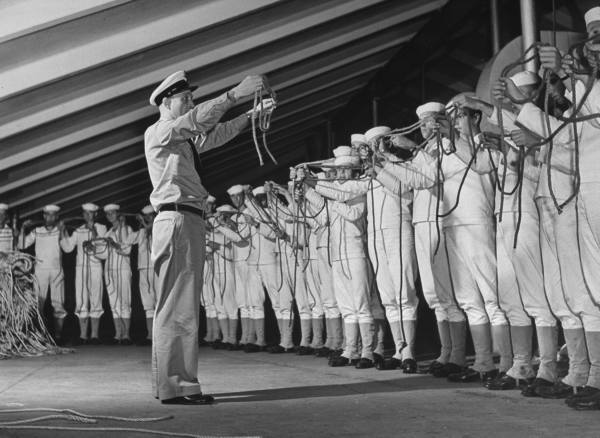 PD USN
PD USN
7 Basic Knots: 7 minutes
Quick Release Knots: 8 minutes
9 most useful sailing knots; 9 minutes
Tying A Mooring Line To A Cleat 2 Minutes
CLEAT HITCHES: https://www.youtube.com/watch?v=QmiYjoUX4lw&index=3&list=PLlEANaBy6Br0WuUtVVDVruWv-OlfA5SqA part of a collection of 2 to 5 minute videos on knotting and splicing.
LONGER AND MORE COMPREHENSIVE INSTRUCTIONAL VIDEOS:
Old Training Film covering numerous knots, rigging boatswain's chairs, etc., 24 minutes
SPLICING
 Image USN
Image USN
THE EYE SPLICE IN # STRAND RIGHT LAID LINE:
Mooring Eye with Thimble: 14 minutes:
https://www.youtube.com/watch?v=2Bv_kf23PAM
HOW TO SPLICE A MOORING LINE:
https://www.youtube.com/watch?v=2Bv_kf23PAM
 PD USN
PD USNCLEAT HITCHES: https://www.youtube.com/watch?v=QmiYjoUX4lw&index=3&list=PLlEANaBy6Br0WuUtVVDVruWv-OlfA5SqA part of a collection of 2 to 5 minute videos on knotting and splicing.
LONGER AND MORE COMPREHENSIVE INSTRUCTIONAL VIDEOS:
 Image USN
Image USNTHE EYE SPLICE IN # STRAND RIGHT LAID LINE:
Mooring Eye with Thimble: 14 minutes:
HOW TO SPLICE A MOORING LINE:
https://www.youtube.com/watch?v=2Bv_kf23PAM
Eye splice in double braid polyester line: https://www.youtube.com/watch?v=Ym1-rI0SdaA
Eye splice in Three Strand line:
https://www.youtube.com/watch?v=pLox_ajDGLo
RIGGING BLOCKS AND TACKLES:
Computing Mechanical advantage and understanding pulley systems: 19 minutes
Computing Mechanical advantage and understanding pulley systems: 19 minutes
The Crosby Group Basic Principles of Block and Tackle Training Video 35 Minutes
DECORATIVE OR"FANCY WORK:
Some examples : 2 minutes
How to make the "monkey's fist: 1minute
DECORATIVE OR"FANCY WORK:
Some examples : 2 minutes
How to make the "monkey's fist: 1minute
How To Tie The Monkey's Fist 5 + minuteshttps://www.youtube.com/watch?v=Q7oyN4LoQfQ
How to Tie the Spinal Sinnet by TIAT
COXCOMBING:
Many more links to videos on "Fancy Work" with any of the above selections. coxcombing and the Monkey's fist are the most commonly known and useful aspects of "Fancy Work " for sailors.
GENERAL SEAMANSHIP:
General Safety: Basic fire prevention, The Fire Triangle, Introductory firefighting, Personal flotation devices, Immersion suits, Man Overboard, etc. Aimed at the recreational boating market but much of this appears in the professional mariner's exams: 40 minute video: https://www.youtube.com/watch?v=aLYkdSqCTh8
STORM TACTICS AND SEA ANCHORS: 1.5 hour video designed for yachtsmen, but much material pertinent to commercial license exams. https://www.youtube.com/watch?v=4SAXRH42Df0
MOORING AND GROUND TACKLE VIDEOS (Multiple assorted):https://www.youtube.com/watch?v=IL16fQw2w74&list=PLOfeVk46tfZ2caWY5MEJvml9zJjRti_JH
-------------------------------------------------------------------------------------------------------------
MOORING AND GROUND TACKLE VIDEOS (Multiple assorted):https://www.youtube.com/watch?v=IL16fQw2w74&list=PLOfeVk46tfZ2caWY5MEJvml9zJjRti_JH
-------------------------------------------------------------------------------------------------------------
STABILITY:

Illustration by: Cmglee, Creative Commons Attribution-Share Alike 3.0 Unported license.
STABILITY IN A NUTSHELL is the art and science of managing a ship's trim in such a manner that the hull's center of gravity and center of buoyancy are in close enough proximity to avoid having the hull become "tippy", that is "unstable". The same mathematical principles apply whether you are attempting to predict the behavior of a small sailing dingy, or a super tanker. However, for professional licenses for deck officers on vessels over 100 gross tons there are usually professional exam questions requiring the candidate to demonstrate an understanding of this concept and the mathematical skills to predict the stability of vessels under various conditions of load. In the offshore oil and mineral industry ratings such as "Ballast Controlmen" must also demonstrate these stability predictive skills. The mathematical equations depicted in these training videos are designed to help the deck officer achieve and maintain stability by such means as adjusting ballast and planning for crgo loading and discharge, and in voyage planning in anticipating changes to stability as the result of burning fuel, consuming stores, changes in waterway salinity, etc. Books help, but we like to provide our visitors with links to free training videos on merchant mariner professional exam subjects whenever we can because everyone has difficulty achieving a 10% retention factor with written materials but nearly everyone has a 50% retention factor on what we see and hear. The resources below found on You Tube are not an exhaustive treatment of the subject, but it appears new videos are being posted on this subject and they are generally found in close proximity to the linked videos below. Good luck!
BASICS:
Stability Unit, Part 1: Introduction to Stability (Part 2, Changes in Center of Gravity, Part 3 Free Surface Effect, Part 4 Initial vs Ultimate Stability, Part 5 Waves follows immediately,
Maritime Training: Ship Stability: Learn Basic Definitions https://www.youtube.com/watch?v=c0DvDRftF1I An excellent video illustrating basic naval architectural terminology needed to understand subjects such as stability and trim.
The Plimsoll Mark: https://www.youtube.com/watch?v=YpCyP1sM_cA The basic mark assigned by the classification society which indicates safe levels of free board for various conditions of load and sea route.Draft Survey _ Basic Concepts Part 1 , 2, 3, & 4https://www.youtube.com/watch?v=XIzGrrYn- Note: The Indian narrator in this training video uses the term "Center of Flotation" ,this seems to be an alternative term for the more commonly used "Center of Buoyancy" in other training videos on stability. You may encounter both terms in this collection of training videos. This is the basic course in computing a ship's basic draft survey, which should be undertaken before leaving port after taking on cargo, or fuel and stores. Following Basic Concepts 1 through 4 this same link continues with trim calculations. Some of the trim calculations video lessons may be a bit redundant with some simpler versions listed below.
Ship Stability_ Definition of Dock Water Allowance ( DWA )
Ship Stability List Formula
The introduction of Equivalent Design Waves (EDW) marks a significant change in the way dynamic loads are calculated in the DNV GL rules. The new advanced load concept is a major step towards a more realistic representation of the environmental loads.
https://www.dnvgl.com/maritime/dnvglrules/hull.html?utm_source=twitter&utm_medium=SocialMediaMaritime&utm_campaign=dnvgl-rules
-------------------------------------------------------------------------
MARINE FIREFIGHTING:
 Photo U.S. Navy
Photo U.S. Navy--------------------------------------------------------------------------------------------------------------
PERSONAL SURVIVAL EQUIPMENT AND LIFEBOATMANSHIP:
Proper procedures for launching a Fast Rescue Boat (FSB)
https://www.youtube.com/watch?v=w0hVUieZTvc about 8 min.video
NOAA SHIP RANIER FAST RESCUE BOAT LAUNCH (about 5 min. video)
https://www.youtube.com/watch?v=cprAz2kdQio
LOWERING AND RECOVERING A LIFE BOAT https://www.youtube.com/watch?v=wks3aFxDyD0 (about 3 minute video)
--------------------------------------------------------------------------
INTRODUCTION TO SIGNALING AND COMMUNICATIONS:
 |
| - USN: ID 020623-N-5329L-007 |
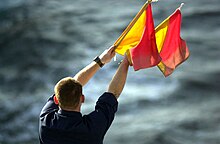
USN Photo ID 020118-N-6520M-011
SEMAPHORE IS A RAPID FORM OF FLAG SIGNALING THAT WORKS BETWEEN VESSELS THAT HAVE A MUTUAL LANGUAGE AND USE THE ROMAN ALPHABET.
Semaphore Signaling In A Minute https://www.youtube.com/watch?v=LZRWNCTQBb8
Whether you are a naval professional, merchant mariner, or recreational boater everyone who operates a vessel of any size on the water would benefit from some level of knowledge of maritime signaling and communications Here we present you with some brief explanations and links to more detailed information, even formal video courses in the International Flag alphabet, the International Code of Signals, Semaphore Flag Signaling, and Morse Code.
THE INTERNATIONAL CODE OF SIGNALS ALLOWS SHIPS TO CROSS LANGUAGE BARRIERS USING THE INTERNATIONAL SIGNAL FLAG SET ILLUSTRATED BELOW FOR MANY COMMON MARITIME COMMUNICATION NEEDS

https://www.youtube.com/watch?v=zOETaUx3c4o Single Flag Signals
https://www.youtube.com/watch?v=YkSWH7n1U6E NATO and INT'l NUMERALS
https://www.youtube.com/watch?v=xh3PDhnP748 Int'l Flags w single flag meaning & Morse code audio equivalent
MORSE CODE COURSE ( FLASHING LIGHT & AUDIO) VIDEO LEARNING RESOURCES:
https://www.youtube.com/watch?v=dGAy3qZGE48&list=PLLlML8Z7kqRKLjXZbkIPsoNy8OLsZ_D4y&index=1 15 Videos to hlep you learn Morse Code
-------------------------------------------------------------------------------------------------------------------
WEATHER/METEOROLOGY:
A Collection of videos on weather monitoring and prediction:
https://www.youtube.com/watch?v=Fc5t6zwVhGs&list=PLoh5LUmaJQwAFoyFTGFkSvsrX3rAIa8NU
Weather Maps Explained: https://www.youtube.com/watch?v=9NZz-EeveJ8
Weather Maps and Symbols: https://www.youtube.com/watch?v=PAubC4_Pd3w
Reading and Interpreting Weather Maps: https://www.youtube.com/watch?v=GkE3F5AuWBQ
--------------------------------------------------------------------------------------------------------------------
SHIP'S BUSINESS AND LAW SECTION
Ship's business and law is a subject that is generally found on officer's license exams at the "any gross tons" or "unlimited tonnage level". The subject is increasing in importance in the daily life of large commercial vessel officers because the staff officer specialist known as a "Purser" is disappearing from the trades. Once common in the crews of almost all seagoing large commercial transports the "Purser" historically prepared all of the documents such as cargo manifests, crew lists, stores lists, and last port visited clearance documents required for formal entry through Customs at the next port of call. The process is known as "entry", the process of gaining formal entry into a foreign port; "pratique" the process of obtaining formal permission from the port authorities to "hold communication with the shore; and "Clearance" the process of satisfying the port authorities that your ship has concluded business, free of reasons to detain her and is "cleared" by port authorities to depart.
-------------------------------------------------------------------------------------------------------------------------------------------------------
Container shipping the world in a box: https://www.youtube.com/watch?v=IDmLEFDDd-c
an introduction to container shipping, this has changed a lot of the paper work and electronic communications associated with entry, pratique, and clearance:
----------------------------------------------------------------------------------------------------------------------------------------------------

License All rights reserved by baasiilb15 Creative Commons License
Interestingly, in admiralty law the words "maritime business", "commerce". etc. are rarely used. Most voyages and maritime endeavors are described as "maritime adventures". Given the element of risk in any ocean enterprise this is hardly surprising. Maritime commerce never would have expanded into the global endeavor it is today if a way to manage the enormous risks involved had not been found. The British crown led the way in the mid 1500s by spreading the risk among contributors organized by Queen Elizabeth into syndicates. If the assured ship made it back intact the syndicate members made a profit from the premium paid for the assurance that the enumerated losses if they occurred would be covered by the syndicate and the ship owner would not be thrown into debtor's prison. By the 1700's an enterprising Brit started a coffee house called "Lloyd's" in London specially designed to attract the syndicate members and ship owners seeking assurance of some maritime adventure. This marked the beginning of the competitive "sale of risk" and the maritime insurance trade as we know it. Today every marine professional, not just those in the admiralty law or insurance professions must have some knowledge of marine insurance. Below are a number of links to specially selected video resources that can give you the basics and the link to the Amazon Marine insurance book shelf for resources for deeper study.
HOW DOES MARINE INSURANCE WORK : 1.5 minute general explanation
INTRODUCTION TO MARINE INSURANCE, THE TRANSFER OF RISK: 10 minute gen. explanation
THE BASICS OF CARGO INSURANCE ("Make Sure You Get "Door To Door Coverage)
THE MARINE INSURANCE CONTRACT: 30 minute general discussion of the key elements in the typical marine contract for insurance


Thank you for your note. The use of the deviation card is an important basic navigational skill. We probably need to beef up the sections dealing with magnetic compass skills.
ReplyDelete